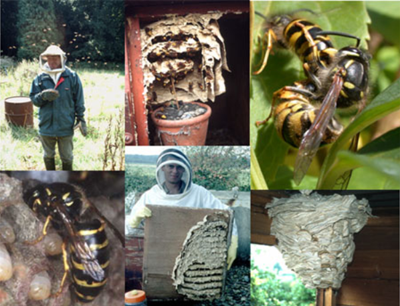The social insects (bees, ants, wasps and termites) provide a test case for any theory of social behaviour because they display one of the most dramatic features of any social species: the evolution of a sterile and self-sacrificial worker caste. As such, the sociobiology of the insects is amongst the most developed subjects in evolutionary biology, and provides an excellent grounding in the underlying logic. Kevin's thesis was on the social insects and we continue to turn to them for inspiration.
We have collaborated with Professor Judith Korb (Osnabrueck University) who has developed the study of termites as a model system in social evolution. We worked together on three studies. The first used RNAi to dissect the genetics of reproductive suppression in termites. This identified a key gene that is central to the division of labour between the queen and the workers (Korb et al. 2009). We then used the termites to show how competition between species can help to drive the evolution of cooperation within species (Korb and Foster 2010). Most recently, we have studied the links between resource value and reproductive behaviour. In particular, we found that termites continually assess the value of their nest and use this to decide on whether they will stay and fight to take over the nest (valuable nests), versus leaving and trying to start their own (low value nests).
Hoffmann K, Foster KR, Korb J. 2012. Nest value mediates reproductive decision making within termite societies. Behavioral Ecology, 23: 1203-1208 ; Korb J, Foster KR 2010 Ecological competition favours cooperation in termite societies. Ecology Letters, 13: 754-760; Korb J, Weil T, Hoffmann K, Foster KR, Rehli M 2009. A gene required for reproductive suppression in termites. Science, 324: 758.
The wasps
Understanding how reproductive conflict is resolved is central to understanding the evolution of cooperation (Ratnieks et al. 2006). The eusocial Hymenoptera (bees, ants, wasps) are particularly interesting in this respect. Their haplodiploid genetics (male haploid and females diploid) and social structure cause diverse and unusual colony kin structures and the potential for a wide range of conflicts. Conflict between the queen and the workers over sex allocation and the production of males appear to be particularly important.
Kevin's thesis focused upon reproductive conflict is the Vespinae (hornets and yellowjackets), the sister group of the more extensively studied Polistinae  (paper wasps). The Vespinae are a relatively small group of four genera with a well-supported phylogeny: Vespa (23 species), Provespa (3 species), Dolichovespula (13 species) and Vespula (22 species). They have a similar basic biology, typically with an annual monogynous colony, enclosed paper nest, a morphologically distinct queen caste and workers that are unable to mate, facilitating across-species comparison based upon differences in kin structure (Foster et al. 2001).
(paper wasps). The Vespinae are a relatively small group of four genera with a well-supported phylogeny: Vespa (23 species), Provespa (3 species), Dolichovespula (13 species) and Vespula (22 species). They have a similar basic biology, typically with an annual monogynous colony, enclosed paper nest, a morphologically distinct queen caste and workers that are unable to mate, facilitating across-species comparison based upon differences in kin structure (Foster et al. 2001).
Kevin assessed family structure in several species of vespine wasps (Foster et al. 1999, 2000, 2001), using this to make predictions about what kinds of reproductive conflicts are likely to occur, and then collecting further data to evaluate these predictions. This showed that kinship can be an important factor in the resolution of reproductive conflicts, although naïve predictions based upon relatedness are not always fulfilled. In addition, they found evidence that workers will eat each other's eggs in vespine wasp societies. Such worker policing behaviour is thought to be a key factor in the resolution of internal conflicts of wasp societies. Tom Wenseleers has more recently done beautiful work on the wasps, showing strong evidence that both relatedness and policing are important in the wasps.
Ratnieks, F.L.W., Foster, K.R. and Wenseleers, T. 2006. Conflict resolution in insect societies. Annual Review of Entomology 51: 581-608 ; Foster KR and Ratnieks FLW. 2001a. Paternity, reproduction and conflict in vespine wasps: a model system for testing kin selection predictions. Behavioral Ecology and Sociobiology, 50: 1-8; Foster KR, Ratnieks FLW. 2001. The effect of sex allocation biasing on the evolution of worker policing in hymenopteran societies. American Naturalist, 158: 615-623.

